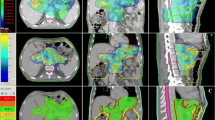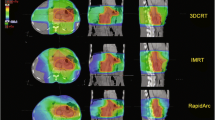Abstract
This study quantified, evaluated and analyzed the radiation dose to which tumors and normal tissues were exposed in 3D conformal radiation therapy (CRT), intensity-modulated radiation therapy (IMRT) and tomotherapy by using a dose volume histogram (DVH) that represented the volume dose and the dose distribution of anatomical structures in the evaluation of treatment planning. Furthermore, a comparison was made for the dose to the gross tumor volume (GTV) and the planning target volume (PTV) of organ to be treated based on the change in field size for three- and four-dimensional computed tomography (3D-CT and 4D-CT) (gating based) and in the histogram with a view to proving the usefulness of 4D-CT therapy, which corresponds to respiration-gated radiation therapy. According to the study results, a comparison of 3D CRT, IMRT with a linear accelerator (LINAC), and tomotherapy demonstrated that the GTV of the cranium was higher for tomotherapy than for 3D CRT and IMRT with a LINAC by 5.2% and 4.6%, respectively. The GTV of the neck was higher for tomotherapy than for 3D CRT and IMRT with a LINAC by 6.5% and 2.0%, respectively. The GTV of the pelvis was higher for tomotherapy than for 3D CRT and IMRT with a LINAC by 8.6% and 3.7%, respectively. When the comparison was made for the 3D-CT and the 4D-CT (gating based) treatment equipment, the GTV and the PTV became smaller for 4D-CT treatment planning than for 3D-CT, which could reduce the area in which normal tissues in the surroundings are exposed to an unnecessary radiation dose. In addition, when 4D-CT treatment planning (gating based) was used, the radiation dose could be concentrated on the GTV, CTV or PTV, which meant that the treatment area exceeded that when 3D-CT’s treatment planning was used. Moreover, the radiation dose on nearby normal tissues could be reduced. When 4D-CT treatment planning (gating based) was utilized, unnecessary areas that were exposed to a radiation dose could be reduced more than they could when 3D-CT treatment planning was utilized. This helped concentrate the radiation dose on the treatment area and, at the same time, reduce the radiation dose to which nearby normal tissues were exposed.
Similar content being viewed by others
References
H. Suit, Int. J. Radiat. Oncol. Biol. Phys. 53, 798 (2002).
S. J. Huh and C. I. Park, J. Korean Soc. Ther. Radiol. Oncol. 18, 167 (2000).
J. H. Cho et al., J. Korean Soc. Ther. Radiol. Oncol. 22, 237 (2004).
S. W. Lee et al., Int. J. Radiat. Oncol. Biol. Phys. 65, 152 (2006).
S. K. Kim, Korean J. Med. Phys. 13, 104 (2002).
K. M. Langen et al., Int. J. Radiat. Oncol. Biol. Phys. 70, 1272 (2008).
K. E. Rusthoven, D. L. Carter, K. Howell, J. Kercher, A. Sandoval, P. Henkenberns, K. Hunter and C. E. Leonard, Int. J. Radiat. Oncol. Biol. Phys. 70, 296 (2008).
S. S. Vedam, P. J. Keall, V. R. Kini and R. Mohan, Med. Phys. 28, 2139 (2001).
N. M. Wink, M. Chao, J. Antony and L. Xing, Phys. Med. Biol. 53, 165 (2008).
R. S. Ahmed, S. Shen, R. Ove, J. Duan, J. B. Fiveash and S. M. Russo, Med. Dosim. 32, 16 (2007).
G. Luxton, P. J. Keall and C. R. King, Phys. Med. Biol. 53, 23 (2008).
G. J. Kutcher, C. Burman, L. Brewster, M. Goitein and R. Mohan, Int. J. Radiat. Oncol. Biol. Phys. 21, 137 (1991).
J. T. Lyman, Int. J. Radiat. Oncol. Biol. Phys. 22, 247 (1992).
V. A. Semenenko and X. A. Li, Phys. Med. Biol. 53, 737 (2008).
S. J. Kim, M. J. Lee and S. M. Youn, J. Korean Soc. Ther. Radiol. Oncol. 29, 99 (2011).
S. M. Yoon, B. Y. Yi, E. K. Choi, J. H. Kim, S. D. Ahn and S. W. Lee, J. Korean Soc. Ther. Radiol. Oncol. 20, 81 (2002).
H. J. Lee et al., Int. J. Radiat. Oncol. Phys. 39, 149 (1997).
D. Tate, Q. T. Le, L. Xing, D. Goffinet, J. Poen, S. Wolden and A. Boyer, Int. J. Radiat. Oncol. Biol. Phys. 42, 223 (1997).
T. Pan, T. Y. Lee, E. Rietzel and G. T. Y. Chen, Med. Phys. 31, 333 (2004).
F. Mohan, Q. Wu, M. Manning and R. Schmidt-Ullrich, Int. J. Radiat. Oncol. Biol. Phys. 46, 619 (2000).
Author information
Authors and Affiliations
Corresponding author
Rights and permissions
About this article
Cite this article
Cho, JH., Lee, HK., Dong, KR. et al. Quantitative analysis of tomotherapy, linear-accelerator-based 3D conformal radiation therapy, intensity-modulated radiation therapy, and 4D conformal radiation therapy. Journal of the Korean Physical Society 60, 1167–1176 (2012). https://doi.org/10.3938/jkps.60.1167
Received:
Published:
Issue Date:
DOI: https://doi.org/10.3938/jkps.60.1167




